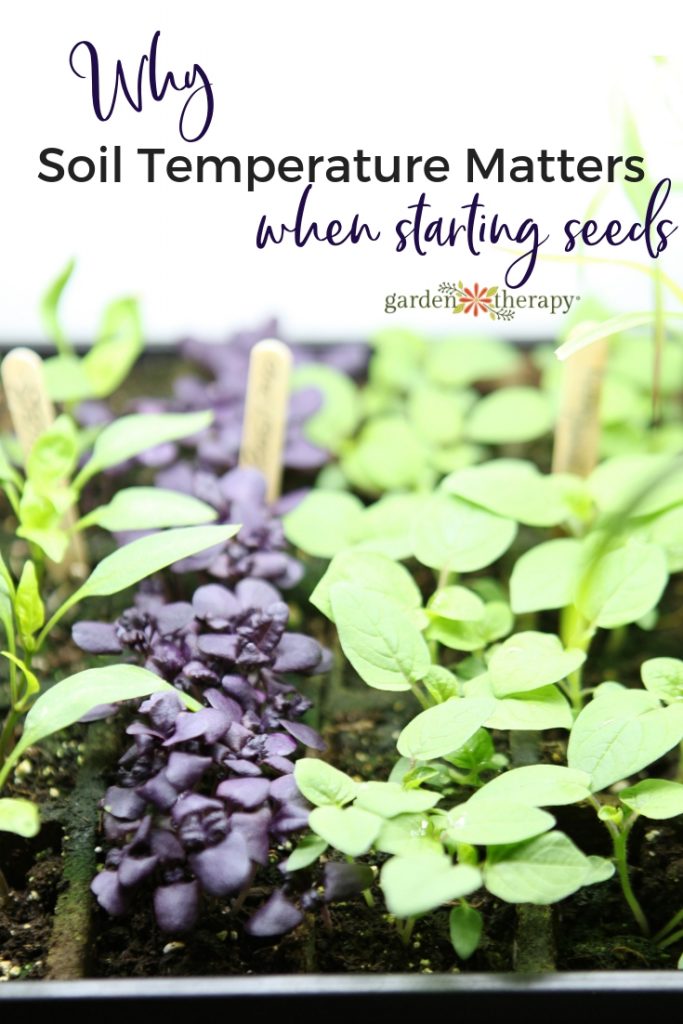One of the most rewarding ways to grow your own vegetables is to start them from seed, plus it’s a great educational experience for kids big and small. Root veggies like carrots, beets and radishes do the best when planted directly in the soil where they will grow as they have a delicate taproot that doesn’t like to be moved. Other garden edibles appreciate the helping hand of growing up a bit indoors before braving the elements. Much of the success of germination and the eventual fruiting of the mature plant, comes from the soil temperature when the seeds are planted.

This post is meant to add specifics to starting the seeds for these very different types of vegetables. If you are new to seed starting, the please read Seed Starting 101 first, as that is the foundation course for all that is seed starting! You can find that post here:
Seed Starting 101
Okay, now back to our regularly scheduled program…
The Importance of Soil Temperature for Starting Seeds
Depending on what you’re growing, it’s important to sow seeds in soil that is the right temperature for their individual needs. Some seeds need warm soil to germinate, and so if you start them indoors, it’s best to do it on heat mats. Starting seeds indoors and moving them to the garden after the last day of frost means an earlier harvest and, in some cases, is essential for growing heat-lovers in climates where the summers are short.
Soil temperature for Solanaceous vegetables (peppers, tomatoes, and eggplant) is critical for seed germination. The soil temperature should be listed on the seed packet, but in general, start heat lovers with a soil temperature of 75° F and they will germinate in 1-2 weeks. Grow them for another 4-5 weeks at that temperature and they are ready to harden off at a lower temperature of 60-65° F to prepare them from the garden.
Solanaceous crops need warmer soil to germinate, while Brassicas (broccoli and cabbage) require cooler soil, although they can be started in a greenhouse at 70°F 2 weeks before the last frost date and grow for about 3-4 weeks for spring plantings and summer harvests. Harden off at 60° F. Alternatively, direct sow in the garden and protect from winds.
Some vegetables seeds, like spinach, prefer cool soil to germinate. Others need a change in soil temperature to be encouraged to grow (for instance a cold period preceding a warming up that signifies that the seasons are changing). The temperature varies with each variety, so refer to your seed culture information on the packaging. And consider using a soil thermometer to monitor soil temperature if you are experiencing difficulty in germination.

Indoor Seed Starting
Heat lovers like tomatoes, peppers, and eggplants should be started indoors with a heat mat to ensure that the soil is warm enough. You can read more about growing heat lovers from seed here.
- Mix the seed-starting soil and water in a bucket to moisten it. It should be moist, but not soggy.
- Make paper pots following the instructions included with the pot maker and fill with soil.
- Set the pots in the bottom of a recycled salad mix box.
- Make a small indent in the top of the soil and plant 2-3 seeds per pot, and cover lightly.
- Label the planted seeds.
- To create a mini greenhouse, cut some air holes in the lid of salad box and cover.
- Once the seedlings emerge, remove the lid altogether and place the seedlings in bright

Direct Sow Seed Starting
Plants that should be sown directly into the soil include Brassicas and root vegetable seeds like carrots, beets, and radishes. Read more about how to grow them from seed here.
- Plant seeds in fertile, well-drained soil that has been cleared of any stones or hard debris that will obstruct the root growth.
- Sow seeds according to the planting depth and spacing recommended on the packet.
- Seeds that are quite small or those you can scatter require thinning after the seedlings sprout.
- Keep the top layer of soil and the seeds moist while they germinate.
- Once sprouted, make sure the seedlings get lots of sun (8 hours/day) and water (don’t let them dry out on hot days).





Comments